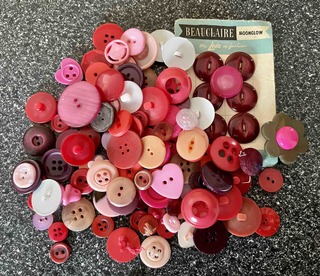The Unique Art of the Humble Button
Buttons have always fascinated me, I remember as a child sifting through the mountain of buttons my mother had in her sewing desk, there were thousands of different sizes and colours, with simple through to intricate designs, and always something to go with anything you were making or a replica to replace buttons that went missing off shirts etc. I myself did a bit of sewing and designed a lot of my own clothes throughout my teen years so I made a habit of collecting buttons too and I have to admit I still have that box of buttons hidden away somewhere, not wishing to part with the fascinating collection. Not sure if anyone here remembers the ‘Xtasy’ clothing range with its huge fluorescent buttons made from a moulding clay called ‘fimo’ in the 1980s, but I do. The fashion this winter seems to be huge buttons too, right up to the size of a coffee mug, but hey at least they’re not fluro! I have a couple of huge buttons that I have painted and turned into brooches so they match certain other accessories when I couldn’t find something in a particular colour way, so they still have some use to me other than for sewing these days.
So what is a button? In modern clothing and fashion design, a button is small fastener, usually made of plastic, although often you see ones made of seashell too. In the applied arts and in craft, a button can be an example of folk art, studio craft, or even a miniature work of art. Buttons are most often attached to articles of clothing but can also be used on containers like wallets and bags as a fastener too. It’s not unusual for buttons to be sewn onto garments and similar items exclusively for purposes of ornamentation. Buttons serving as fasteners work by slipping through a fabric or thread loop, or by sliding through a buttonhole.
Buttons can be individually crafted by artisans, craftspeople or artists from raw materials or found objects like fossils or recycled rubbish, or even a combination of both. Alternately, they can be the product of low-tech cottage industry or can be mass-produced in high-tech factories. Buttons made by artists are art objects, known to button collectors as ‘studio buttons’.
Nowadays, hard plastic, seashell and wood are the most common materials used in button-making; the others tending to be used only in premium or antique apparel, or found in collections. Because buttons have been manufactured from almost every possible material, both natural and synthetic, and combinations of both, the history of the material composition of buttons reflects the timeline of materials technology. Historically, fashions in buttons have also reflected trends in applied aesthetics and the applied visual arts, with button-makers using techniques from jewellery making, ceramics, sculpture, painting, printmaking, metalworking, weaving and others. The following are just a few of the construction and decoration techniques that have been used in button-making:
Shank buttons have a hollow protrusion on the back through which thread is sewn to attach the button so you don’t see the thread from the front at all. Button shanks may be made from a separate piece like wire which is added to the back of the button in a loop, or they can be carved or moulded directly onto the back of the button, this button is referred to by collectors as having a 'self-shank'.
Flat or sew-through buttons have holes through which thread is sewn to attach the button. Flat buttons may be attached by sewing machine rather than by hand, and may be used with heavy fabrics by working a thread shank to extend the height of the button above the fabric. Generally they have two or four holes for sewing to the garment.
Covered buttons are fabric-covered forms with a separate back piece that secures the fabric over the knob. These are good for items like bags or wallets and clothing where you wish for them to be exactly the same colour or material as the item they are being attached to. Really effective when used with unusual materials.
Worked or cloth buttons are created by embroidering or crocheting tight stitches (usually with linen thread) over a knob or ring called a form.
Mandarin buttons or Frogs are knobs made of intricately knotted strings. Mandarin buttons are a key element in Mandarin dress, where they are closed with loops. Pairs of mandarin buttons worn as cuff links are called silk knots.
Posted: Sunday 6 June 2010
